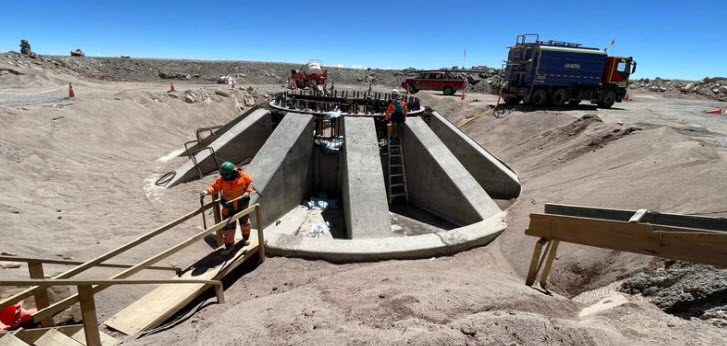The Fred Young Submillimeter Telescope (FYST) construction is entering its crucial phase.
It is being planned and built by the international scientific consortium CCAT Observatory Inc. in which the universities of Cologne and Bonn have a 25% share.
The FYST, also known as CCAT-prime (Cherro Chajnantor Atacama Telescope-prime), has a mirror diameter of 6 meters, making it designed to operate in the submillimeter to millimeter wavelength range.
It will be located 5,600 meters above sea level on Cerro Chajnantor mountain in Chile, overlooking the Atacama Large Millimeter/submillimeter Array (ALMA).

FYST’s novel optical design will provide high-throughput imaging with a large field of view, enabling fast and efficient sky mapping.
Work will soon begin on the critical component that will support the telescope’s upper structure along with its mirrors.
This component will be made of Invar, a type of steel with an extremely low coefficient of thermal expansion.
“That means the structure won’t expand when it’s hot or shrink when it’s cold,” says project leader Jim Blair of international project partner Cornell University.
“At least with Invar, that coefficient is very low compared to conventional steel. That’s important for science because at these wavelengths we’re studying, the thermal expansion would affect the data and could skew it.”
Blair adds, “We can thus use FYST to observe wavelength ranges that few other telescopes can even pick up because of their design elements and the materials used”.
The telescope’s mirrors are also state-of-the-art, according to Blair.
They are currently being built in the Netherlands by Airborne, a world leader in carbon fiber.
The internal steel skeletal structures for two of the yoke arms that will hold the three-story elevation section in place are nearly complete.
Then, all of these massive pieces will be assembled into the lower sections that have already been completed, which will bring the telescope to near completion.
The project team expects that the test phase for the telescope can start in Germany towards the end of 2023.
Wessel GmbH will carry out the test assembly in Xanten.
Its location near the University of Cologne facilitates exchange with the team at Vertex Antennentechnik GmbH in Duisburg, which is developing the telescope.
“This allows us to work closely with the designers to follow the intricacies of telescope development in detail – right down to the exact positioning of the electrical connections,” says Dr. Ronan Higgins, deputy CCAT-prime project engineer at the Institute of Astrophysics at the University of Cologne.
“I’ve already visited various regional sites and interacted with assemblies from different suppliers. This gives you a lot of appreciation for the many people working behind the scenes to make this project happen.”
The CCAT-prime observatory also involves young scientists: doctoral students are involved in astronomical research and the telescope’s commissioning, such as the holographic alignment of the mirror field.
“I have been working on developing the holography system at the Cologne Institute for Astrophysics for the past three years. We have successfully tested the system in the laboratory with an accuracy of two micrometers and look forward to integrating it into the telescope in 2023,” said Ph.D. student Xiaodong Ren.
Due to the extreme altitude of the telescope’s location on Cerro Chajnantor in the Chilean Andes (it will be the second-highest telescope in the world, the highest being just fifty meters above it on the mountain’s summit), the entire telescope will be constructed and pre-assembled in Germany.
It will then be disassembled into about twelve large pieces and reassembled in Chile.
It is anticipated that the telescope will be shipped to Chile in 2024.
This complicated undertaking will be organized by Vertex GmbH and is expected to take at least four months.
On-site in Chile, the Chilean construction company Consorcio FVV Ingeniería y Construcción Limitada has also done important work recently.
The nine-kilometer trench from the base camp at 5,000 meters, where the observatory’s power generation facility will be located, to the top of the mountain has now been completed — the main power and fiber optic cables for data transmission run along this trench.
Extreme conditions complicate work at the telescope site at 5,600 meters. Workers must be specially trained and pass an exam to be approved to work at this altitude.
Even after that, they can work a maximum of 12 to 13 days. For every working day at extreme altitudes, members of the 108-man construction crew must spend a day further down, at around 2,700 meters.
A final project this spring will be a concrete tank for an 80,000-liter fuel tank to ensure that no environmental damage will result from a potential fuel leak.
The tank will be one and a half times the size of the fuel tank, Blair explained, so it won’t overflow in snow or rain.
The main power generators already procured, along with the electronics cabinets, switchgear, and transformers will be the final components installed at the base camp before the telescope itself arrives for installation at the summit.
This work is scheduled to begin in the third quarter of 2023, so the power system can be operational no later than early 2024.
“This project is pretty much the largest that a consortium of universities and research institutions can tackle,” says Professor Dr. Dominik Riechers, head of the Submillimeter Astronomy Group at the Institute for Astrophysics.
“Here in Cologne, dozens of students at the bachelor’s and master’s levels as well as researchers and engineers, are working in our highly specialized workshops and laboratories to make the project a reality. We are all very much looking forward to using this extraordinary facility from 2024.”

